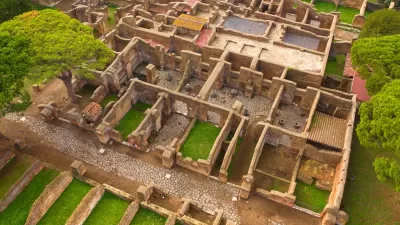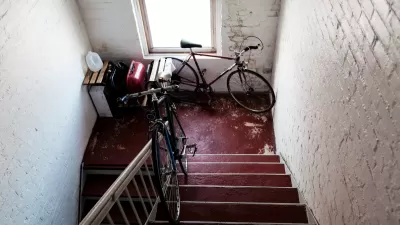The humble apartment, as a typology, has been with us for millennia.

The urban apartment, while it may feel like a modern invention, dates back thousands of years, writes Ashley Gardini in a piece for JSTOR Daily.
In the Americas, the ancient city of Teotihuacan housed up to 200,000 people in compact compounds. “While these may have looked a bit different than what we think of as apartments today, evidence shows that these structures ‘generally consist[ed] of several rooms at slightly different levels, arranged around open spaces (courtyards, refuse areas, and light wells) that serve[d] as places for ritual, rainwater collection, partial refuse disposal, and light provision.’” In ancient Rome, ‘insulae’ of up to five stories housed residents of crowded cities.
Later in history, planners and leaders attempted — with varying degrees of success — to sanitize and organize cities by building massive apartment blocks. As technology evolved, so did the ability of builders to construct larger and taller buildings. “In the twenty-first century, even as we continue to build larger and taller structures, architecture needs to respond to the climate crisis and other evolving environmental factors.” A wood-based material called mass timber is being explored as a sustainable alternative to other construction materials that is strong enough to use in buildings of up to 25 stories (to date).
FULL STORY: The Eternal, Essential Apartment

Study: Maui’s Plan to Convert Vacation Rentals to Long-Term Housing Could Cause Nearly $1 Billion Economic Loss
The plan would reduce visitor accommodation by 25,% resulting in 1,900 jobs lost.

North Texas Transit Leaders Tout Benefits of TOD for Growing Region
At a summit focused on transit-oriented development, policymakers discussed how North Texas’ expanded light rail system can serve as a tool for economic growth.

Why Should We Subsidize Public Transportation?
Many public transit agencies face financial stress due to rising costs, declining fare revenue, and declining subsidies. Transit advocates must provide a strong business case for increasing public transit funding.

How Community Science Connects People, Parks, and Biodiversity
Community science engages people of all backgrounds in documenting local biodiversity, strengthening connections to nature, and contributing to global efforts like the City Nature Challenge to build a more inclusive and resilient future.

Alabama: Trump Terminates Settlements for Black Communities Harmed By Raw Sewage
Trump deemed the landmark civil rights agreement “illegal DEI and environmental justice policy.”

Dear Tesla Driver: “It’s not You, It’s Him.”
Amidst a booming bumper sticker industry, one writer offers solace to those asking, “Does this car make me look fascist?”
Urban Design for Planners 1: Software Tools
This six-course series explores essential urban design concepts using open source software and equips planners with the tools they need to participate fully in the urban design process.
Planning for Universal Design
Learn the tools for implementing Universal Design in planning regulations.
City of Santa Clarita
Ascent Environmental
Institute for Housing and Urban Development Studies (IHS)
City of Grandview
Harvard GSD Executive Education
Toledo-Lucas County Plan Commissions
Salt Lake City
NYU Wagner Graduate School of Public Service





























